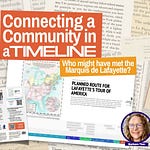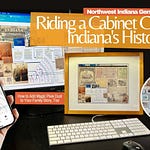The concept for “Dress Your Ancestors” starts with the idea that an old photograph of a beloved ancestor can be the starting point for an investigation into the life they lived. When you think about their experiences, it’s as if you were dressing them the way you might dress a paper doll. Your work will give thoughtful consideration to who they were, where they lived, and whom they might interact with.
This approach perfectly suits the challenge of combining facts to bring an ancestor's story to life and is the spirit of the Swedish idiom, “Klä på dina förfäder.”
Session Recording
Hearty thanks to Anna Scheutz, our long-time Ponga member and now our first Projectkin member to step up to present a Project Recipe. In this session, she talked about a project she's worked on several ways to learn about and then shared the story of Sofia Charlotta Westlund.
Notes & resources
The following links mentioned during the program may be useful:
At the beginning of the recording, listen to how Anna describes the initial event that piqued her interest in Sofia Charlotta's story and then how she engaged in the story for a variety of different audiences including other genealogists, and then her own family.
This particular ancestor of Anna's was remarkable not only for the life she led but also for the fact that her 97 years between 1813 and 1910 spanned not only the Industrial Revolution but also a period of tremendous growth and change in Sweden.
I loved several of her observations, including:
When you work on a project, realize that they not only bring your subject to life, you can also think of the project itself as alive and constantly changing because you can go back do more research, edit and repurpose the work into a variety of media and audiences.
Anna talked about how she's used the core elements of Sofia Charlotta's life for a variety of cases from a presentation to her "After Researching" Facebook group, a chapter in a book and now is exploring turning this presentation below into a video and a scavenger hunt for her nephews and nieces.
On the video, there's a lovely passage at 48:48 where Ann Larkham summarizes the talk and what it's inspired in a gem of a moment. You won't want to miss that.
Tools she mentioned as useful included:
A Swedish book about History for Family Historians. She suggested looking for similar books in your own area as they provide useful context to appreciate the environment your ancestors lived and and tips for finding more relevant content for your stories. Here in the US, "Genealogists' US History Pocket Guide" is probably an example.
Finally, the resources mentioned:
Ann Larkham's upcoming 6-part course for the UK Society of Genealogists on Photogenealogy
eBook publishing too Anna's used for publishing her story in printed form: Reedsy
You won't want to miss next week's Project Recipe: "Family Trees and Burls-Project recipe for a child’s teaching ebook" with Kerri Kearney on October 5th.
I'm doing another "Tutorial Tuesday" next week, October 3rd on Canva whiteboards (essentially using the tool as I did in my Project recipe event on Sept 14. See recording below.)
Slides used in the presentation
Project Recipe
This recipe is intended for the benefit of all Projectkin member subscribers. If you’ve managed to find this and are not yet a member, well, good for you.















Share this post